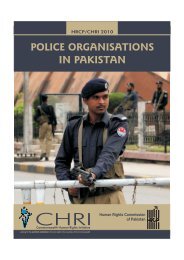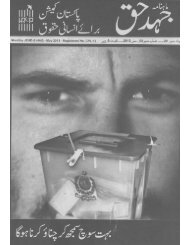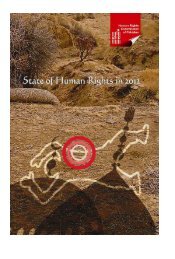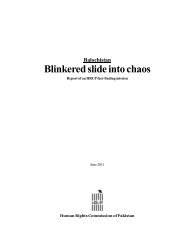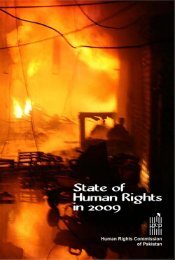Download PDF file - HRCP
Download PDF file - HRCP
Download PDF file - HRCP
Create successful ePaper yourself
Turn your PDF publications into a flip-book with our unique Google optimized e-Paper software.
Conflict in Balochistan 64<br />
noticed any significant advance in the education sector. The high school in her village did not have a headmaster. Four<br />
other schools too were without headmasters, and one had been recently appointed. The degree college had 3,000<br />
students but inadequate facilities. There was no woman teacher at the degree college. 24 posts of lecturers were<br />
vacant at the college for boys. A woman teacher at Tump alleged that teachers and students were exploited by<br />
institutions’ administration. The high school at Mand had no science teacher. Often, it was said, posts of teachers<br />
were created but not filled.<br />
At Khuzdar, some young men complained that there were doubts about the permanence of the local university<br />
and a large number of seats had been given to Quetta (affecting the district quota). Many seats at the university<br />
remained unfilled. The Lecturers’ Association alleged that college premises were not properly maintained. A degree<br />
college for boys and an intermediate college for girls were in a dilapidated condition. There were no residential<br />
facilities for lecturers. Public interest in higher education for girls had increased but there was no hostel for them and<br />
no facilities for the female staff. An inter-college at Awaran had been set up in a jungle, far away from the town.<br />
There were no facilities for lecturers. There was no electricity either.<br />
The government residential college (boys) at Loralai was praised for its standard of teaching but its expenses<br />
were considered somewhat higher than people’s means. Similar observations were made about a high school and an<br />
inter-college for girls.<br />
Health<br />
In Turbat, there was one District Headquarters Hospital for a population of 650,000 people while there were six<br />
rural health centres and 52 basic health units, and some health centres had been set up by NGOs. The <strong>HRCP</strong> team<br />
was told there had been no allocation for medicines for three years. The facilities at the hospital were far from<br />
satisfactory. Out of the four gynaecologists at the hospital, three were away on training and the fourth was absent<br />
from duty till 11 a.m. Nurses and Lady Health Visitors were attending to delivery cases. The women who had<br />
travelled from far flung areas felt unhappy and frustrated. Their anxiety level was high. The X-ray unit had no films.<br />
However, HIV test facilities were available and doctors took the initiative to raise funds through public donations to<br />
run the laboratories.<br />
The public concerns voiced before the <strong>HRCP</strong> team included: anxiety over the local maternal mortality rate being<br />
the highest in the world; absence of LHVs in the rural areas; significant incidence of malaria and communicable<br />
diseases and lack of eradication measures; water shortage, impurities in drinking water and unhygienic conditions<br />
near wells.<br />
Similar complaints were heard at Khuzdar. The DHQ Hospital was said to be poorly equipped. There was no<br />
gynaecologist and LHVs looked after delivery cases. The staff was non-cooperative. Maternal mortality was high.<br />
Disaster management<br />
At several places <strong>HRCP</strong> heard complaints that those affected by natural disasters did not receive adequate or<br />
timely succour. At Khuzdar, the hardships faced by the drought/famine affectees were specifically stressed. It was<br />
said that relief packages were inadequate. The provincial government was urged to provide relief over longer periods.<br />
In Loralai, which depends almost solely on agriculture and fruit / vegetable cultivation, seven years of drought<br />
had played havoc with the local economy. A large number of fruit trees had died. Many families were forced to<br />
abandon their farms and homes. The provincial government built a few dams but these were found inadequate. The<br />
relief promised by the federal government did not fully materialise.<br />
Archaeological sites and cultural relics:<br />
There was no say for the local community in the preservation of such sites. Cultural relics from Shahi Jumbh,<br />
Balinagar and Dasht had been expropriated by unauthorised people.



